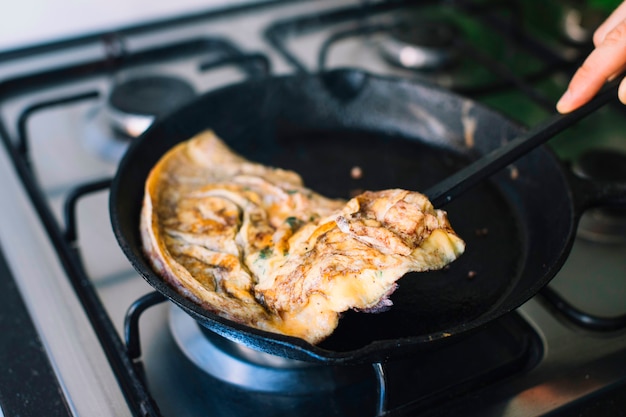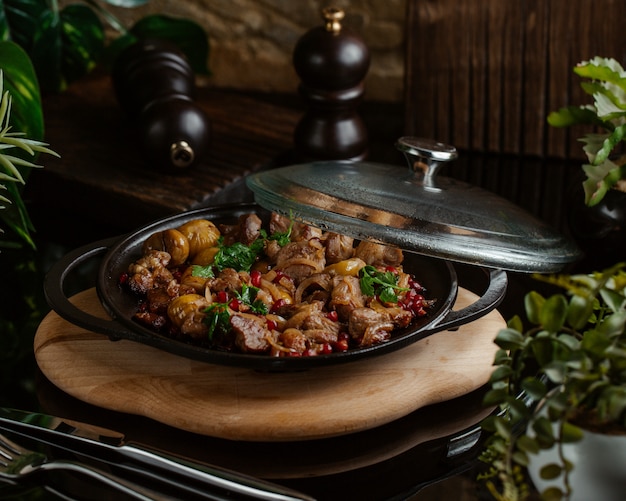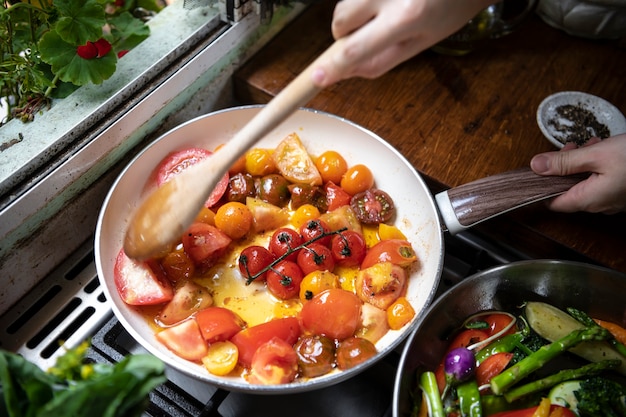Let's be honest, filet mignon is the king of steaks. It's the epitome of indulgence, the kind of dish that makes you feel fancy even if you're just eating it at home on a Tuesday night. But the idea of cooking it can be intimidating. You might envision yourself battling a scorching oven, frantically checking the timer, and inevitably overcooking that beautiful cut of meat.
I'm here to tell you that you don't need an oven, a fancy thermometer, or any culinary expertise to cook a perfect filet mignon. In fact, a simple pan-searing technique, done right, can deliver restaurant-quality results in your own kitchen. And it's a lot less stressful than you think.
Now, I'm not going to pretend I'm a Michelin-star chef, but I have a bit of a steak obsession. I've tried every method from grilling to sous vide, but it was pan-searing that truly won me over. It's straightforward, it delivers incredible flavor, and it gives you absolute control over the cooking process. And when it comes to steak, control is king.
(Part 1) Getting Started: Choosing the Right Filet

Before we even think about firing up the stove, let's talk about the star of the show – the filet mignon itself. As I always say, good food starts with good ingredients, and that's especially true for steak. I'm a bit of a meat snob, so I prefer to get mine from a butcher I trust, but if you're shopping at the supermarket, look for filet mignon labelled "USDA Prime" or "Choice." These grades mean you're getting a well-marbled cut with plenty of flavor.
Picking the Perfect Filet: A Guide for the Uninitiated
Here's how to find the best filet mignon at the butcher counter or in the supermarket:
- Look for even marbling: This is the key to a tender, juicy steak. Think of it like a beautiful, swirled pattern of fat running through the meat.
- Feel the firmness: A good filet mignon should feel firm and springy to the touch. It shouldn't be overly soft, as that might indicate it's not as fresh.
- Check the colour: A deep, even red is what you're aiming for. Avoid any fillets with discoloration or unusual smells.
- Trust your gut: If something doesn't look right, trust your instinct. It's better to be safe than sorry.
(Part 2) Prepping the Filet for Perfection

Alright, you've got your beautiful piece of meat. Now, it's time to prep it for pan-searing. This is where the real magic begins. It's all about bringing the meat to room temperature and seasoning it properly. This might sound like a simple step, but trust me, it makes a world of difference.
Room Temperature: The Key to Even Cooking
Let's be honest, cooking a cold steak is a recipe for disaster. It won't cook evenly, and you'll end up with a tough, chewy center. That's why it's crucial to let your filet mignon sit at room temperature for at least 30 minutes before you start cooking. This allows the steak to warm up evenly, ensuring a perfect cook from edge to center. I learned this the hard way – there's nothing worse than biting into a cold, undercooked center.
Seasoning: Salt, Salt, and More Salt
Now, let's talk about the seasoning. Salt is your best friend when it comes to steak. It brings out the natural flavor of the meat and helps create a beautiful, crispy crust. But you don't just sprinkle it on – you want to "salt the meat." This involves a specific technique that elevates your steak to a whole new level.
Here's how I salt my filet mignon:
- Pat the filet dry: Use paper towels to remove any excess moisture. This ensures the salt adheres properly and prevents the pan from steaming.
- Generously salt all sides: Go for a generous amount of salt, making sure to cover every inch of the surface.
- Let it rest: This is the crucial part. Let the filet sit uncovered in the fridge for at least an hour, ideally two. This allows the salt to penetrate the meat and draw out some of the moisture, which concentrates the flavor and creates a perfectly seasoned crust.
I'll admit, I was a bit skeptical about this salt-aging technique at first. But trust me, it's a game-changer. It transforms a simple steak into something truly special.
(Part 3) Mastering the Pan-Searing Technique

Right, it's time for the fun part – the actual pan-searing. Now, this is where precision is key. You need a good quality pan, preferably cast iron or stainless steel. These pans retain heat well and allow for even browning, resulting in that beautiful, crispy crust we're aiming for. But don't worry if you don't have a fancy pan. A good quality non-stick pan will work just fine.
The Importance of a Sizzling Hot Pan
The first rule of pan-searing is to get your pan scorching hot. You want it to be sizzling when you add the steak. This high heat is what creates that delicious sear, sealing in the juices and flavor. If your pan isn't hot enough, you'll end up with a pale, limp steak, which is a culinary tragedy.
Oil is Your Friend (Especially the Right Kind)
Add enough oil to generously coat the bottom of your pan. I prefer using a neutral oil with a high smoke point, like avocado oil or grapeseed oil. These oils can handle high temperatures without burning, ensuring a clean, crisp sear.
Searing to Perfection: A Three-Minute Love Affair
Now, get ready to fall in love with the sizzle. Carefully place the filet mignon in the hot pan and don't move it for at least three minutes! Let it sit there, developing that glorious crust. Resist the urge to poke it or flip it too early. This is the secret to a truly delicious steak. After three minutes, flip the steak over and repeat the process on the other side.
The Art of Resting: Patience is a Virtue
That beautiful sear is a thing of beauty, but the cooking isn't over yet. Now comes the most important part – letting the steak rest. Remove it from the pan and place it on a cutting board for 5-10 minutes before cutting into it. This allows the juices to redistribute throughout the meat, resulting in a steak that is unbelievably juicy and tender. You might think the steak is done cooking, but it's actually finishing the process as it rests. It's a beautiful thing.
(Part 4) Reaching Your Desired Doneness
Now, here's a topic that can be a bit controversial – steak doneness. Everyone has their preference, from the rare and juicy to the well-done and slightly dry. But the key is knowing how to get the doneness you desire.
Understanding the Levels of Doneness: A Visual Guide
Here's a breakdown of the different levels of doneness, so you can confidently cook your steak to perfection:
| Doneness | internal temperature | Description |
|---|---|---|
| Rare | 125-130°F (52-54°C) | Cool centre, red throughout, softest texture |
| Medium-Rare | 130-135°F (54-57°C) | Slightly warm centre, pink throughout, tender texture |
| Medium | 135-140°F (57-60°C) | Warm centre, pinkish-brown throughout, slightly firmer |
| Medium-Well | 140-145°F (60-63°C) | Hot centre, brown throughout, firm texture |
| Well-Done | 145-150°F (63-66°C) | Very hot centre, completely brown, firmest texture |
meat thermometer: Your Secret Weapon
I'll admit, I used to go by feel when it came to doneness. But after a few "overcooked" steaks, I learned the value of a meat thermometer. It's a game-changer! It lets you accurately measure the internal temperature of your steak, ensuring you cook it exactly to your liking.
The "Finger Test": A Handy Trick (But Not as Accurate)
While a meat thermometer is the most accurate way to check doneness, there's a little trick I use to get a sense of the steak's temperature. It's called the "finger test." You simply press your finger against the fleshy part of your palm. The firmness of your palm at that spot corresponds to different levels of doneness:
- Rare: Similar to the fleshy part of your thumb
- Medium-Rare: Similar to your middle finger
- Medium: Similar to your index finger
- Medium-Well: Similar to your pinky finger
It's not as accurate as a thermometer, but it's a good way to get an idea of the steak's temperature if you don’t have a thermometer handy.
(Part 5) Elevating Your Filet Mignon with Sauces
Alright, your filet mignon is cooked to perfection, it's rested, and it's the perfect temperature. Now for the finishing touch – the sauce! A good sauce can really elevate your filet mignon to a whole new level, adding a burst of flavor and richness.
Classic Options: A Trip Down Flavor Memory Lane
There are countless sauce options, but I'll share a few of my favorites:
- Béarnaise: A rich and creamy sauce made with egg yolks, butter, tarragon, and white wine vinegar. It's a classic for a reason, and it pairs beautifully with the richness of filet mignon.
- Red Wine Reduction: This simple yet elegant sauce is made with red wine, shallots, and butter. It's perfect for balancing the richness of the steak and adding a hint of complexity.
- Mushroom Sauce: A hearty and savory sauce made with sautéed mushrooms, garlic, and cream. It's a great option for those who love a mushroom flavor, and it complements the steak beautifully.
Simple and Delicious: A Butter Sauce for the Win
If you want a quick and easy option, try a simple butter sauce. It's surprisingly delicious, and it takes just a few minutes to make.
Ingredients:
- 2 tablespoons butter
- 1 tablespoon chopped fresh parsley
- 1 clove garlic, minced
- Pinch of salt
- Pinch of black pepper
Instructions:
- In a small saucepan, melt the butter over low heat.
- Add the parsley, garlic, salt, and pepper.
- Stir until the garlic is fragrant.
- Pour the sauce over the steak, garnish with additional parsley, and enjoy!
(Part 6) Mastering the Art of Serving
Alright, your filet mignon is cooked to perfection, you've got your delicious sauce, now it's time to plate it up and present it with pride.
The Ultimate Presentation: A Culinary Masterpiece
I like to make my steak presentation a little dramatic. It's all about showcasing that beautiful, perfectly cooked steak.
- Use a nice plate: A simple white plate works best, but feel free to get creative with colours and patterns.
- Create a bed of mashed potatoes or polenta: This provides a beautiful contrast to the steak and gives it a nice base.
- Place the steak on the plate: Make sure it's positioned in the centre of the plate, the star of the show.
- Spoon the sauce over the steak: Don't be shy! Let it flow over the sides for a visually appealing presentation.
- Garnish with fresh herbs: A sprig of rosemary, a few sprigs of thyme, or some chopped parsley will add a touch of colour and freshness.
side dishes that Complement: The Perfect Supporting Cast
Now, don't forget the side dishes! You need something to complement the richness of the steak. Here are a few ideas:
- Roasted Vegetables: roasted brussels sprouts, asparagus, or broccoli florets provide a nice contrast in texture and flavour.
- Creamy Risotto: The creamy richness of risotto is a perfect pairing for steak.
- Simple Salad: A fresh salad with a light vinaigrette adds a touch of lightness to the meal.
(Part 7) Embracing the "Imperfections"
Listen, we've all been there – that moment you’re about to serve your steak, and it's not quite perfect. Maybe it's a little overcooked, the crust isn't as crisp as you hoped, or the sauce is a little runny. But you know what? Don't get discouraged.
Perfecting Your Technique: A Journey, Not a Destination
Cooking is all about practice. It's about trying new techniques, experiencing different flavors, and learning from your mistakes. Every steak I cook teaches me something new, and that's what makes cooking so exciting.
Finding Joy in the Imperfect: A Culinary Embrace
And let's be honest, sometimes the "imperfections" are what make the dish even more delicious. That little bit of char on the steak adds a smoky flavor, a runny sauce can create a beautiful glaze, and a slightly overcooked steak can still be tender and flavorful. It's all about embracing the unique qualities of each dish.
(Part 8) FAQs: Your Pan-Seared Filet Mignon Questions Answered
Alright, let's address some common questions you might have about pan-searing filet mignon:
FAQs:
1. Can I use a different cut of meat?
Absolutely! While filet mignon is the classic choice, you can use other cuts of beef like ribeye, new york strip, or even flank steak. Just adjust the cooking time accordingly.
2. What if I don’t have a cast iron pan?
As I said, a good quality non-stick pan will do the trick just fine. Just make sure it's heatproof and can handle high temperatures.
3. How do I know when the steak is done?
Use a meat thermometer to check the internal temperature. If you don’t have one, try the finger test.
4. What if the steak sticks to the pan?
Make sure your pan is hot enough and that you've added enough oil. If it still sticks, try loosening it with a spatula.
5. What if I overcook the steak?
It happens! The best thing you can do is cut the steak and serve it. It might be a bit firmer than you wanted, but it will still be delicious.
Final Thoughts
So there you have it! Pan-searing filet mignon is easier than you think. With a few simple steps and a bit of practice, you can create a delicious and impressive meal that will impress your guests (or yourself). Remember, cooking is a journey, not a destination. Don't be afraid to experiment, and most importantly, enjoy the process. Happy cooking!
Everyone is watching

Prime Rib Roast Cooking Time Chart: Per Pound Guide
Cooking TipsPrime rib roast. Just the name conjures images of lavish dinners, crackling fires, and hearty laughter. It’s ...

How Long to Bake Potatoes in the Oven (Perfect Every Time)
Cooking TipsBaked potatoes are a staple in my kitchen. They're incredibly versatile, delicious, and surprisingly easy to m...

Perfect Rice Every Time: The Ultimate Guide to Cooking Rice
Cooking TipsAs a self-proclaimed foodie, I've always been a bit obsessed with rice. It's the foundation of countless cuisi...

The Ultimate Guide to Cooking Asparagus: Tips, Techniques, and Recipes
Cooking TipsAsparagus. The mere mention of this spring delicacy conjures up images of vibrant green spears, crisp and burs...

Ultimate Guide to Cooking the Perfect Thanksgiving Turkey
Cooking TipsThanksgiving. Just the word conjures up images of overflowing tables laden with delicious food, the scent of r...
